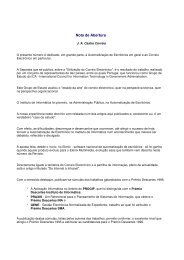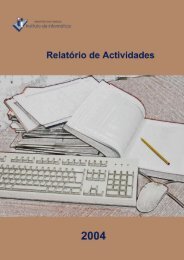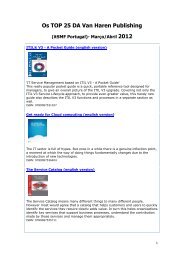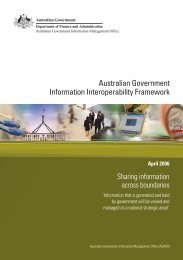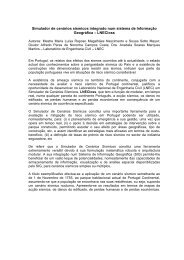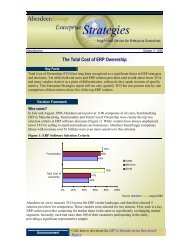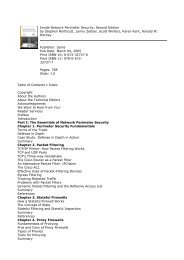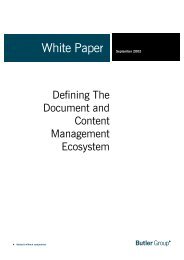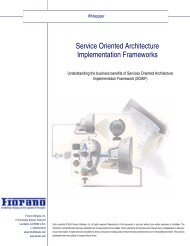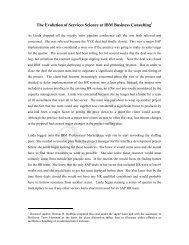OECD Peer Review of E-Government in Denmark - ePractice.eu
OECD Peer Review of E-Government in Denmark - ePractice.eu
OECD Peer Review of E-Government in Denmark - ePractice.eu
You also want an ePaper? Increase the reach of your titles
YUMPU automatically turns print PDFs into web optimized ePapers that Google loves.
outright barriers. The clearest evidence <strong>of</strong> this fact is provided by the general progress <strong>Denmark</strong> is<br />
mak<strong>in</strong>g with its e-government programme.<br />
Key po<strong>in</strong>t 3.2<br />
While organisations report fac<strong>in</strong>g budgetary barriers to e-government, there is no data available to verify whether<br />
and/or to what extent this is a real problem <strong>in</strong> <strong>Denmark</strong>. At the level <strong>of</strong> <strong>in</strong>dividual organisations there appears to<br />
be sufficient budgetary flexibility, and availability <strong>of</strong> <strong>in</strong>struments for longer-term budget<strong>in</strong>g and targeted budgetary<br />
assistance, to enable organisations to proceed with properly prioritised e-government <strong>in</strong>itiatives. Lack <strong>of</strong><br />
awareness, weak or miss<strong>in</strong>g <strong>in</strong>centives, and/or an absence <strong>of</strong> some support<strong>in</strong>g frameworks that would enable<br />
organisations to properly exploit these arrangements appear to be the ma<strong>in</strong> impediments to overcome <strong>in</strong> this<br />
area.<br />
Two areas <strong>of</strong> particular challenge that are understood and be<strong>in</strong>g addressed as part <strong>of</strong> the e-government strategy<br />
are: 1) the need for better, more robust and consistent bus<strong>in</strong>ess cases for e-government <strong>in</strong>itiatives; and 2) the<br />
so-called “sow/harvest” problem, which distorts <strong>in</strong>centives for organisations to participate <strong>in</strong> multi-agency<br />
e-government <strong>in</strong>itiatives. Alongside work be<strong>in</strong>g led by the M<strong>in</strong>istry <strong>of</strong> F<strong>in</strong>ance and the Digital Task Force to<br />
develop better bus<strong>in</strong>ess case and project f<strong>in</strong>anc<strong>in</strong>g models and tools, <strong>of</strong>ficials hope that the <strong>in</strong>troduction <strong>of</strong> accrual<br />
account<strong>in</strong>g <strong>in</strong> 2007 will help alleviate these problems.<br />
Technological environment<br />
The technological environment outside government organisations (particularly the<br />
communications <strong>in</strong>frastructure) is strongly supportive <strong>of</strong> the development <strong>of</strong> e-government <strong>in</strong><br />
<strong>Denmark</strong>. On the supply side, the telecommunications market is competitive, provid<strong>in</strong>g for a high<br />
level <strong>of</strong> access to relevant technologies such as broadband Internet connections and mobile services.<br />
On the demand side, Danish consumers (both <strong>in</strong>dividuals and bus<strong>in</strong>esses) show strong rates <strong>of</strong><br />
adoption <strong>of</strong> PCs, broadband services and mobile phones.<br />
In 2004, <strong>Denmark</strong> placed first <strong>in</strong> the annual IDC Information Society Index, and <strong>in</strong> 2005 it topped<br />
The Economist magaz<strong>in</strong>e’s annual “e-Read<strong>in</strong>ess Rank<strong>in</strong>gs”. Both rank<strong>in</strong>gs are partially determ<strong>in</strong>ed on<br />
the basis <strong>of</strong> countries’ ICT environment (see Box 3.2).<br />
Box 3.2 Measur<strong>in</strong>g ICT read<strong>in</strong>ess: <strong>Denmark</strong>’s rank<strong>in</strong>gs <strong>in</strong> two <strong>in</strong>ternational surveys<br />
In 2005, <strong>Denmark</strong> scored first <strong>in</strong> The Economist’s annual “e-Read<strong>in</strong>ess Rank<strong>in</strong>g”, which is based on assessment<br />
<strong>of</strong> countries’: 1) connectivity and technology <strong>in</strong>frastructure (25% weight<strong>in</strong>g); 2) bus<strong>in</strong>ess environment (20%); 3)<br />
levels <strong>of</strong> consumer and bus<strong>in</strong>ess adoption <strong>of</strong> ICT (20%); 4) legal and policy environment (15%); 5) social and<br />
cultural environment (15%); and 6) support <strong>of</strong> e-services (5%). The connectivity and technology <strong>in</strong>frastructure<br />
measure is based on: 1) penetration <strong>of</strong> fixed-l<strong>in</strong>es, broadband, mobile phones and the Internet; 2) quality <strong>of</strong><br />
Internet connections; 3) levels <strong>of</strong> competition <strong>in</strong> the telecommunications <strong>in</strong>dustry; and 4) security <strong>of</strong> the<br />
<strong>in</strong>frastructure. Adoption measures look at the prevalence <strong>of</strong> e-bus<strong>in</strong>ess practices and the extent to which the<br />
Internet is used to overhaul and automate traditional bus<strong>in</strong>ess processes, and on State <strong>in</strong>vestment <strong>in</strong> ICT and<br />
other factors that <strong>in</strong>form these practices.<br />
Further confirmation <strong>of</strong> the strength <strong>of</strong> the technological environment for e-government <strong>in</strong> <strong>Denmark</strong> is provided by<br />
the International Data Corporation (IDC) Information Society Index (ISI) for 2004. The ISI comb<strong>in</strong>es 15 variables<br />
<strong>in</strong> four <strong>in</strong>frastructure “pillars” to calculate and rank nations’ ability to access and utilize <strong>in</strong>formation and <strong>in</strong>formation<br />
technology (53 nations were <strong>in</strong>cluded <strong>in</strong> 2004). The four pillars are:<br />
- Computers: the number <strong>of</strong> PCs <strong>in</strong> households, IT spend<strong>in</strong>g as a percentage <strong>of</strong> GDP, s<strong>of</strong>tware spend<strong>in</strong>g as a<br />
percentage <strong>of</strong> total IT spend<strong>in</strong>g, and IT services spend<strong>in</strong>g weighted aga<strong>in</strong>st GDP.<br />
- Internet: the number <strong>of</strong> users, the number with Internet access at home, the number <strong>of</strong> mobile Internet users,<br />
and e-commerce spend<strong>in</strong>g.<br />
- Telecommunications: broadband adoption, wireless services, and mobile handset shipments.<br />
52



